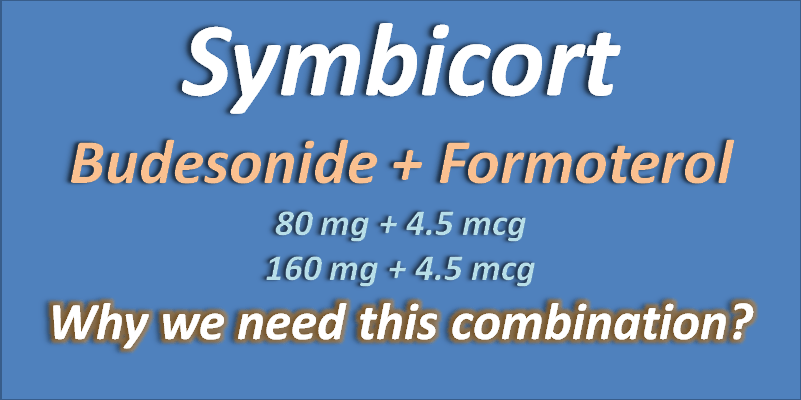Is budesonide/formoterol combination safe to use in asthma?
by egpat Posted on 08-12-2017
You may often observe budesonide/formoterol combination under the brand name symbicort that is indicated in patients with asthma. Is this combination safe?
Are both drugs produce similar effects?
No, they have quite different actions.
Are they acting by similar mechanism?
No, their targets and mechanism of action are different.
Are they chemically related?
No.
Then why they are combined?

Yes. Even though they differ in many aspects they have a common point that they can be used in asthma.
Let’s have more clarity by discussing about each drug individually.
Budesonide
Budesonide is one of the glucocorticoids that has wide usage in respiratory disorders like asthma or any respiratory inflammatory conditions.
It works as anti-inflammatory agent which reduces the inflammatory cascade that underlies the pathological condition like asthma decreasing the number of asthmatic attacks in the patient.
So budesonide is not a bronchodilator and it has no action on bronchospasm.
Formoterol
On the other hand, formoterol is a beta 2 agonist that selectively acts on bronchial smooth muscle that causes relaxation.
So simply it is bronchodilator that relives from bronchospasm in asthmatic patients. It is long acting than albuterol.
What is need of budesonide/ formoterol combination?
That’s the main area we are discussing here.
What the symptoms you observe in patients with asthma or COPD?
Symptoms like difficulty in breathing, wheezing and coughing are observed in asthma and the similar symptoms but to the higher extent with severe bronchospasm are common in COPD.
As formoterol is a long acting bronchodilator it can reduce the bronchospasm both in the patients with asthma or COPD.
Isn’t it?
Yes, No doubt in that. Then what is use of adding budesonide?
Formoterol can reduce the bronchospasm, but can it prevent further attack?
Certainly the answer is ‘no’.
You can observe bronchospasm as a symptom in asthma or COPD but the underlying pathaological condition involves bronchial inflammation.
Inflammatory cells like monocytes and macrophages are accumulated within the bronchial smooth muscle staging for more severe attacks in the future.
They also increase the responsiveness of the bronchial smooth muscle so that even a mild stimulus can precipitate asthma.
Here budesonide comes into the picture.
It is an anti-inflammatory agent that can inhibit the development f inflammation within the bronchial smooth muscle and can also suppress release f inflammatory mediators that exaggerate the condition in asthma.
This prevents frequent attacks as well as hyper responsiveness in the asthmatic patients improving their life style.
Can budesonide/formoterol be used for acute conditions?
Definitely ‘no’, they can’t.
Even though formoterol is a bronchodilator, this combination should not be used for acute reversal of bronchospasm and any gradual deteriorating conditions of asthma and COPD.
A short acting beta 2 agonist is best preferred in such conditions to quickly reverse the bronchospasm.
Similarly this combination should not be used for treatment of status asthmaticus.
How they are combined?
Budesonide and formoterol are combined in a single suspension that can be given by inhalation through aerosols.
Symbicort is available at two strengths.
- 80 mg of budesonide + 4.5 mcg of formoterol
- 160 mg of budesonide + 4.5 mcg of formoterol
Side effects
As both of the drugs in this combination have their own side effect profile, the budesonide/formoterol inhalation shows a list of side effects.
Since formoterol is a beta 2 agonist, it may increase sympathetic activity leading to symptoms like
- Increased blood pressure
- Irregular heart beats
- Chest pain
- Headache
- Nervousness
Beta 2 agonists also increase twitch tension of the muscle leading to
- Tremors
Many of the other side effects are related to budesonide.
As budesonide is a corticosteroid it can a fungal infection in the mouth commonly called as thrush. So the patient should be advised to rinse the mouth after each inhalation.
Similarly budesonide also acts as immunosuppressant increasing the risk of other infection resulting in
- Pneumonia
- Fever
- Pain
- Chills
- Body pains
- Nausea
Other side effects of budesonide are just similar with other corticosteroids in the class. They include
- Decreased bone mineral density
- Glaucoma
- Risk of cataracts
- Reduced growth in the children
- Decreased potassium levels in plasma
- Increased plasma glucose levels
FDA warnings
US FDA placed a warning on use of long acting beta 2 agonists (LABA) for treatment of asthma which may increase the risk of asthma related death in the patients.
So, budesonide/formoterol combination should be used only in those patients who are not adequately controlled with inhalation corticosteroids.
Even it was suggested that if this combination is prescribed, it should be gradually withdrawn in those patients who are brought under the control of asthma or COPD after its use.
Conclusion
Addition of budesonide to formoterol brings advantage in the therapy by preventing recurrent attacks of asthma and COPD but still this combination has many limitations in use.
This combination has many side effects like bone demineralisation, adrenal suppression, growth retardation and a warning of sudden asthma-related death. Even it can’t be used for sudden restoration of breathing problems.
Hence budesonide/formoterol (symbicort) combination should not be used in every situation but should be restricted to use in the patients who are resistant to the treatment with other drugs to establish safe and efficient therapy.